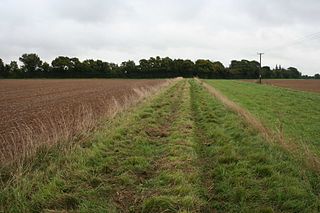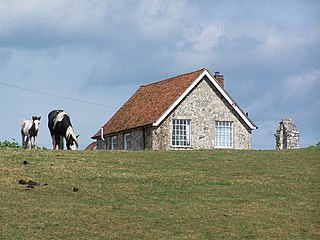
Francis Lovell, 9th Baron Lovell, 6th Baron Holand, later 1st Viscount LovellKG was an English nobleman who was an ally of King Richard III during the War of the Roses. Sir William Catesby, Sir Richard Ratcliffe and he were among Richard's closest supporters, famously called "the Cat, the Rat and Lovell our dog" in an anti-Ricardian squib. In addition to being an ally, Lovell is attributed as Richard's best friend.

Akeman Street was a major Roman road in England that linked Watling Street with the Fosse Way. Its junction with Watling Street was just north of Verulamium and that with the Fosse Way was at Corinium Dobunnorum. Evidence suggests that the route may well have been an older track, metalled and reorganised by the Romans. Its course passes through towns and villages including Hemel Hempstead, Berkhamsted, Tring, Aylesbury, Alchester, Chesterton, Kirtlington, Ramsden and Asthall.
Sopwell Priory was built c. 1140 in Hertfordshire, England by the Benedictine abbot of St Albans Abbey, Geoffrey de Gorham. It was founded as the Priory of St Mary of Sopwell and was a cell of St Albans Abbey.

The Old Minster was the Anglo-Saxon cathedral for the diocese of Wessex and then Winchester from 660 to 1093. It stood on a site immediately north of and partially beneath its successor, Winchester Cathedral.
Mitre Square is a small square in the City of London. It measures about 77 feet (23 m) by 80 feet (24 m) and is connected via three passages with Mitre Street to the SW, to Creechurch Place to the NW and, via St James's Passage, to Duke's Place to the NE.

Minster Lovell Hall is a ruin in Minster Lovell, an English village in the Oxfordshire Cotswolds. The ruins are situated by the River Windrush.

Winchester Cathedral Priory was a cathedral monastery attached to Winchester Cathedral, providing the clergy for the church. Cenwealh son of Cynegils is credited with constructing the Old Minster of Winchester in the 640s, and a new bishopric was created in the 660s with Wine as the first bishop. Although attacked by the Vikings in 860 and 879, the monastery survived and recovered.

St Oswald's Priory was founded by Æthelflæd, daughter of Alfred the Great, and her husband Æthelred, ealdorman of Mercia, in the late 880s or the 890s.
Plympton Priory was a priory in Devon, England. Its history is recorded in the Annales Plymptonienses.
Brimpsfield Priory was a priory in Gloucestershire, England.
Newent Priory was a priory in Gloucestershire, England.
Pamber Priory is a Church of England parish church and former priory, then known as Sherborne Priory, at Monk Sherborne in the English county of Hampshire.
Lewisham Priory was a medieval monastic house in London, England.

Ivychurch Priory was a medieval monastic house in Alderbury, near Salisbury, Wiltshire, England. After the Dissolution of the Monasteries it became a private house and estate in the Herbert family. Sir Philip Sidney wrote most of his Arcadia there, and it lay within the sphere of Wilton House and the literary society which was encouraged there by Mary Sidney Herbert.
Ashfield Secondary Modern School was a coeducational secondary modern school in York, England. Its site on the corner of Tadcaster Road and Sim Balk Lane in York was taken over by York Sixth Form College, which later merged with York College of Further and Higher Education to become York College. After many years of use by York College as A-Level classrooms for subjects including art, music, law, politics and mathematics, the Ashfield buildings were demolished in 2005 to make way for a new building for York College which opened in 2007.

Betar Bangla is a British radio station based in London aimed at the Bangladeshi community in the UK.












